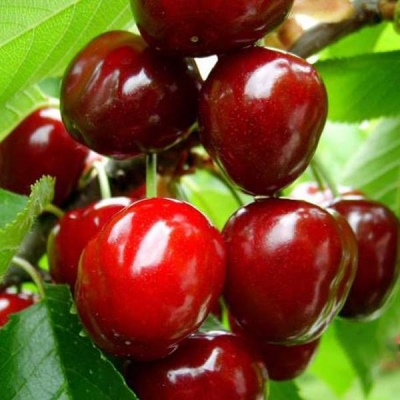
- Fruit shape: oval
- Peduncle: medium length and thickness
- Authors: M.V. Kanshina, A.E. Sedov (All-Russian Research Institute of Lupine)
- Appeared when crossing: Muscat black F2 х Leningrad black F2
- Year of approval: 2005
- Growth type: medium-sized
- Appointment: universal
- Yield: high
- Crown: wide round, medium density
- Escapes: horizontal, drooping at the bottom, of medium length and thickness
Cherry Sadko is a popular variety that gardeners like for its high yield and resistance to most pests and diseases. It is worth taking a closer look at the features and advantages of wood.
Breeding history
Sadko was bred artificially by domestic breeders. The tree has incorporated the best properties of two well-known hybrid varieties of sweet cherries: Muscat black F2 and Leningrad black F2.
Description of the variety
The tree belongs to a group of plants with an early maturity. Specifications:
the crown is wide-rounded and of medium density;
dark gray bark;
cone-shaped kidneys;
small leaves of narrow oval shape and green color.
The tree forms white large flowers, collected in inflorescences of 3 pieces each. Fruits develop on twigs.
Fruit characteristics
Sadko pleases gardeners with large fruits weighing from 6.1 to 8.1 g. Characteristics:
shape - oval;
color - dark red;
the skin is dense with a few subcutaneous points.
The standard peduncle is easily detached from the branches. The berries are suitable for fresh and canned consumption. The fruits make excellent jams, compotes.
Taste qualities
Tasters rate the taste of the popular variety at 4.7 points. The fruits contain sugar, dry substances, ascorbic and other acids. The fruit has a juicy dessert taste and bright aroma. The pulp is dense, has good transportability. The round bone is easily detached.
Ripening and fruiting
Cherry begins to bloom early, the berries ripen in the fourth year, are formed simultaneously in early July.

Yield
The average yield is 46 centners per hectare. The maximum reaches 104 c / ha.
Self-fertility and the need for pollinators
Cherry Sadko is a self-fertile variety, therefore, requires pollinators nearby. Otherwise, the tree will bloom but not bear fruit.
Growing and care
A competent approach to planting and growing crops will help to achieve a bountiful harvest. First of all, it is worth deciding on a place for planting a young tree.
Preference should be given to the slopes of the southeast or southwest direction, where the areas are well lit and protected from unpleasant drafts.
The water table must be deep to prevent root rot, which grows 2 m into the ground.
You should not plant cherries in lowlands, where melt water lingers for a long time, which causes the death of the plant by rot.
When choosing a soil, it is better to stop on loam or sandy loam.
For cherries to bear fruit, pollinators must grow nearby. Usually, they are played by other varieties of sweet cherry or cherry, in which the flowering period coincides with Sadko.Young varieties are planted mainly in the spring, when warm weather sets in the street.
The tree planting scheme is as follows.
A couple of weeks before disembarkation, holes up to 80 meters deep are dug in a pre-selected area. The recess must be at least 1 meter in diameter.
The bottom of the pit is covered with a fertile layer of soil and fertilizers.
A peg is driven into the recess, providing a protrusion 50 cm above the surface.
The seedlings are placed in pits, carefully digging in the remaining space, followed by compaction of the soil.
When the cherries are planted, they are abundantly watered and mulched with organic ingredients. After planting, it is worth providing correct and timely care for the plant. The main components.
Watering. Sweet cherries are demanding for watering during the growing season and fruiting, when it is necessary to apply a large amount of water. Towards autumn, watering should be reduced, and then stopped altogether.
Top dressing. The first fertilizers are applied before planting seedlings. Then the tree is left to grow for 3 years, after which the plant is again fed with nitrogen compounds. The same fertilizers are applied to the soil during the fruiting period and before frost.
Pruning. There are two types: formative and sanitary. Young trees are exposed first, forming the crown. The second option is held every season in spring and autumn.
Loosening. The procedure should be carried out in late spring and summer, when the tree is actively bearing fruit. Loosening can be done manually or using a cultivator, the time of the process is after watering.
Additionally, gardeners recommend carrying out preventive work to strengthen the plant's immunity.




Disease and pest resistance
The variety is highly resistant to many pests and diseases. The tree is not affected by coccomycosis, moniliosis and clasterosporiosis. However, gardeners recommend, for prevention purposes, to carry out treatment with special formulations before the beginning of cherry blossoms.

































































